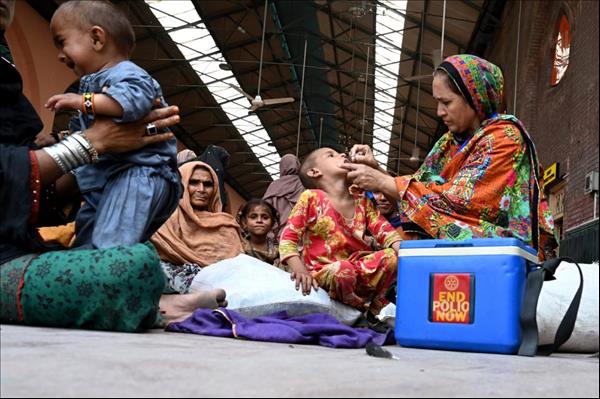(MENAFN- Asia Times) Despite decades of vaccine development, smallpox remains the only disease ever to be fully eradicated by vaccination. By the end of 2026, the Global Polio Eradication Initiative (GPEI) plans for polio to be added to that short list.
Poliomyelitis, more commonly known as polio, is a highly infectious virus that can cause paralysis or death. , there is no cure for polio, and the only hope for containment lies in vaccination.
Since the launch of the GPEI in 1988, global polio cases have fallen by around 99%, and two of the three wild-virus varieties have been eradicated. Southeast Asia and Africa have been declared polio-virus free, and there are now just two countries where the virus remains endemic: Afghanistan and Pakistan.
Cases in both countries have risen since 2014, compounded by conflict and security problems, natural disasters, and the Covid-19 crisis, all of which have undermined efforts to vaccinate communities.
In Afghanistan, there were 56 officially reported cases in 2020 (and likely many more that went unreported), up from 29 the previous year. In 2020, Pakistan saw 84 cases of polio, and 20 cases have been detected this year already, mostly in the virus hotspot of Khyber Pakhtunkhwa.
Failure to control and eradicate endemic polio in these two countries poses a health threat far beyond their borders.
Three challenges must be overcome if polio is to follow smallpox into extinction. First, at the global level, donors need to increase their financial commitment to the GPEI. Second, national – and especially sub-national – government institutions must better coordinate and prioritize efforts to reach all communities. The final, and biggest, challenge is to reduce community mistrust and vaccine hesitancy in places like Afghanistan and Pakistan.
At the World Health Summit in Berlin last month, – which included $1.2 billion from the Bill and Melinda Gates Foundation – to fund the GPEI's five-year polio-eradication strategy. However, this leaves a of almost $1.9 billion.
In the current climate of global and financial instability, donors may be unwilling to step up. There has been of the United Kingdom, for example, for cutting its funding for polio eradication by 95% last year.
This makes the role of regional donors more important. The United Arab Emirates, for instance, has been a long-standing supporter of eradication efforts, especially in Pakistan; the UAE has given that country more than $200 million since 2014 to pay for of vaccine, protection for more than 100 million children.
Amid the international shortfall, Middle Eastern donors may find themselves under increased pressure to provide more funding.
International financing is important, but commitment and support at national and district levels is also critical to successful polio campaigns. Governments need to ensure both adequate infrastructure as well as safe access for health workers. District-level governments, though, often suffer a dearth of resources and find it difficult to juggle multiple and sometimes competing priorities.
In Pakistan, recent floods have diverted attention and spending from other programs, but the : As part of the humanitarian responses, emergency health facilities have been used to provide routine immunizations, including for polio, to affected children.
Eradication efforts in Afghanistan are even more fraught. Before 2021, several Taliban-controlled district administrations banned local polio campaigns. Since taking control of the central government in August last year, the Taliban have . But remote regions have less infrastructure, are hard to reach and are often governed by local officials who may provide less support.
An estimated 700,000 Afghan children by immunization teams.
The biggest challenge is overcoming vaccine hesitancy in communities deeply suspicious of health campaigns. Parents can refuse to allow their children to be vaccinated, and health workers can face threats of violence. Not only does this leave these communities at significant risk, it also creates pockets of virus reservoirs from which a wider regional and even global resurgence could occur.
To eradicate polio, vaccination coverage must be high. The most common vaccine uses a weakened but still live form of the virus. In well-vaccinated communities, this weakened virus – which is excreted and can therefore be transmitted – is innocuous. But in places where large parts of a community remain unvaccinated, the vaccine can mutate into strains that can create symptomatic polio, including paralysis.
This form – known as – has been growing globally over the past decade, with recent outbreaks in parts of Africa that have eradicated wild polio virus. Greater efforts at engaging and working with communities are essential if vaccination is to be successful, and if wild and cVDPV forms of the virus are to be wiped out.
Vaccine hesitancy is not just about mistrust and ignorance. In February, were murdered in northern Afghanistan. This shows how local, national, and even international politics and tensions can create mistrust and suspicion around vaccination campaigns, undermining efforts to control the virus.
After the United States reportedly used a as part of its efforts to capture al-Qaeda leader Osama bin Laden in Pakistan in 2011, anti-vaccine campaigns and attacks on vaccinators increased, leading to a marked decrease in vaccination rates in parts of the country.
The next four years are an opportunity to eradicate polio once and for all. But doing so will require coordination to ensure the global, national, and local level challenges are addressed. Failure to ensure full funding, to improve coordination, and to win the trust of communities will be an opportunity wasted, the consequences of which would be devastating.
This article was provided by , which holds copyright.




















Comments
No comment